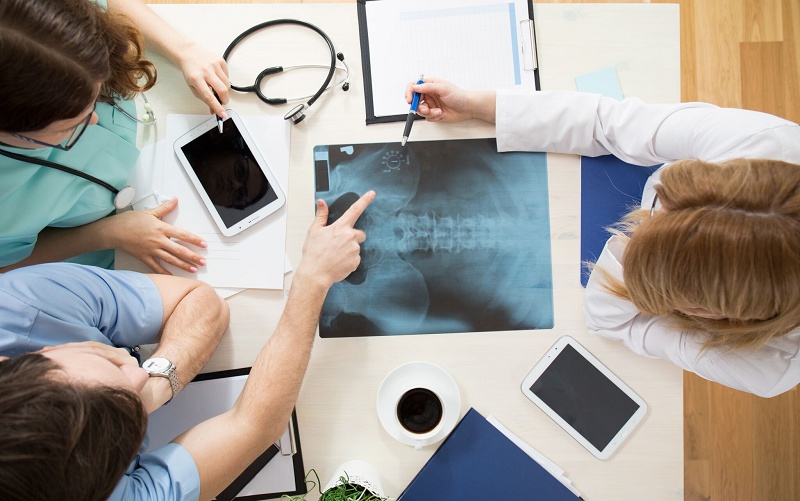
As a radiographer, you will use cutting-edge technology to take images of patients’ insides to better understand and diagnose disorders. You will build treatment plans with patients and colleagues in a hospital and help patients until their therapy is finished.
Apprentice radiographers analyse a patient’s body and establish the cause of their illness using several imaging technologies and procedures.
You’ll be working with some of the most sophisticated and cutting-edge technology, such as
- angiography
- computerised tomography (CT)
- fluoroscopy
- MRI (magnetic resonance imaging)
- ultrasound
- x-ray.
As a radiographer, you’ll take photographs to help diagnose illness and injury in various medical areas.
You can also help with image interpretation, treatment plan formulation, and intervention procedures such as kidney stone removal if you have the necessary knowledge.
Radiographers also play a vital role in a wider interdisciplinary team, working and consulting with colleagues from many disciplines.
Responsibilities
Throughout your apprenticeship, you may help:
- produce and interpret high quality images of the body to identify and diagnose injury and disease
- screen for abnormalities
- take part in surgical procedures like biopsies (examining tissues to find the cause of disease).
Salary
- As a newly qualified radiographer your starting salary is likely to be £27,055 (Band 5), rising up the pay scale to £32,934. Agenda for Change (AfC) pay rates
- As an experienced radiographer you can earn between £33,706 and £40,588 (Band 6).
- Typical salaries for advanced practice and management roles are between £41,659 and £48,526 (Bands 7 to 8a). Consultants can earn in excess of this.
Working hours
You’ll typically work a standard 37.5-hour week, which may include shift work, weekends, nights and bank holidays, as well as on-call working.
Working environment
You could work in an NHS or private hospital or at a hospice.
Your working environment may be physically and emotionally demanding.
You may need to wear protective clothing and a uniform.
Qualifications
Qualifications you can achieve as an apprentice radiographer include:
- Level 6 Diagnostic Radiographer– Entry requirements for this level include 4 or 5 GCSEs at grades 9 to 4 (A* to C) and A levels, or equivalent, for a higher or degree apprenticeship.
This typically takes 36 months to complete as a mix of learning in the workplace and academic study at an approved university.
Skills
On a radiography apprenticeship, you’ll learn:
- knowledge of medicine and medical procedures
- sensitivity and understanding
- to be thorough and pay attention to detail
- knowledge of biology
- the ability to think clearly using logic and reasoning
- active listening skills
- concentration skills
- thinking and reasoning skills
- to be able to use a computer and the main software packages confidently.
Employers
The NHS employs the largest majority of diagnostic radiographers in the UK, although opportunities exist in private hospitals and clinics.
You’ll mostly work in hospital radiology and imaging departments, but you may also offer mobile imaging in emergency, critical care, neonatal, and operating rooms. Working at GP surgeries and clinics is another possibility.
You might also work in research or teaching, conducting studies and training radiographers. Other options include veterinary medicine, customs and excise, prisons, and the military.
You might also work for an equipment manufacturer as a sales representative or application specialist, providing training and help to personnel when new equipment is placed in hospital departments.
In countries like Australia and Canada, there are chances to work in hospitals, clinics, and educational or research organisations.
Professional development
You will go through an induction period as a newly qualified radiographer, typically followed by a term of preceptorship. During this time, you will get familiar with the workplace’s regulations and procedures and have the opportunity to reflect on your practice while being clinically supervised by a senior colleague.
To maintain your HCPC registration, you must engage in continuous professional development (CPD). This ensures that you are up to date on the latest treatment and care breakthroughs and technological developments. In addition, you will be submitted to clinical supervision regularly during your career.
The Society of Radiographers provides its members with continuing professional development activities, including courses, seminars, conferences, events, and a range of networking opportunities.
You may further your skills by pursuing a post-registration certification in diagnostic radiography at the PGCert, PGDip, or MSc level. You might also seek a PhD in an area that interests you.
Management certifications are quite valuable when looking for a management career.
Career prospects
Radiographers often have good career prospects, and you may move through the NHS grading system to positions in both clinical and administrative settings.
As your career progresses, you may graduate to the advanced practitioner level, assuming additional clinical responsibility and patient management. However, only a small percentage of radiographers advance to the level of consultant, where they contribute to the strategic development of services.
There are also opportunities to progress into research or to teach future diagnostic radiographers.
You might also work as a manager in the NHS, education, agencies or charities, concentrating on themes such as quality assurance or patient care and information and support services.
